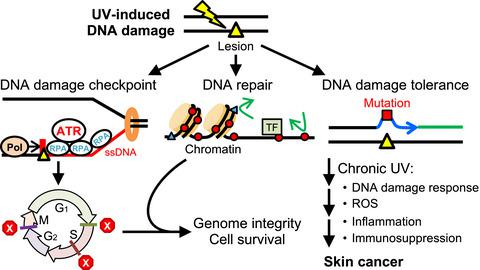当前位置:
X-MOL 学术
›
Photochem. Photobiol.
›
论文详情
Our official English website, www.x-mol.net, welcomes your feedback! (Note: you will need to create a separate account there.)
Deciphering UV‐induced DNA Damage Responses to Prevent and Treat Skin Cancer
Photochemistry and Photobiology ( IF 3.3 ) Pub Date : 2020-05-01 , DOI: 10.1111/php.13245 Jihoon W. Lee, Kajan Ratnakumar, Kai‐Feng Hung, Daiki Rokunohe, Masaoki Kawasumi
Photochemistry and Photobiology ( IF 3.3 ) Pub Date : 2020-05-01 , DOI: 10.1111/php.13245 Jihoon W. Lee, Kajan Ratnakumar, Kai‐Feng Hung, Daiki Rokunohe, Masaoki Kawasumi

|
Ultraviolet (UV) radiation is among the most prevalent environmental factors that influence human health and disease. Even 1 h of UV irradiation extensively damages the genome. To cope with resulting deleterious DNA lesions, cells activate a multitude of DNA damage response pathways, including DNA repair. Strikingly, UV‐induced DNA damage formation and repair are affected by chromatin state. When cells enter S phase with these lesions, a distinct mutation signature is created via error‐prone translesion synthesis. Chronic UV exposure leads to high mutation burden in skin and consequently the development of skin cancer, the most common cancer in the United States. Intriguingly, UV‐induced oxidative stress has opposing effects on carcinogenesis. Elucidating the molecular mechanisms of UV‐induced DNA damage responses will be useful for preventing and treating skin cancer with greater precision. Excitingly, recent studies have uncovered substantial depth of novel findings regarding the molecular and cellular consequences of UV irradiation. In this review, we will discuss updated mechanisms of UV‐induced DNA damage responses including the ATR pathway, which maintains genome integrity following UV irradiation. We will also present current strategies for preventing and treating nonmelanoma skin cancer, including ATR pathway inhibition for prevention and photodynamic therapy for treatment.
中文翻译:

解读紫外线诱导的 DNA 损伤反应以预防和治疗皮肤癌
紫外线 (UV) 辐射是影响人类健康和疾病的最普遍的环境因素之一。即使 1 小时的紫外线照射也会广泛破坏基因组。为了应对由此产生的有害 DNA 损伤,细胞会激活多种 DNA 损伤反应途径,包括 DNA 修复。引人注目的是,紫外线诱导的 DNA 损伤形成和修复受染色质状态的影响。当细胞进入带有这些病变的 S 期时,会通过易错的跨病变合成产生独特的突变特征。长期暴露在紫外线下会导致皮肤的高突变负荷,从而导致皮肤癌的发展,这是美国最常见的癌症。有趣的是,紫外线诱导的氧化应激对致癌作用具有相反的作用。阐明紫外线诱导的 DNA 损伤反应的分子机制将有助于更精确地预防和治疗皮肤癌。令人兴奋的是,最近的研究揭示了关于紫外线照射的分子和细胞后果的大量新发现。在这篇综述中,我们将讨论紫外线诱导的 DNA 损伤反应的更新机制,包括 ATR 通路,它在紫外线照射后保持基因组完整性。我们还将介绍当前预防和治疗非黑色素瘤皮肤癌的策略,包括用于预防的 ATR 通路抑制和用于治疗的光动力疗法。我们将讨论紫外线诱导的 DNA 损伤反应的更新机制,包括 ATR 途径,它在紫外线照射后保持基因组完整性。我们还将介绍当前预防和治疗非黑色素瘤皮肤癌的策略,包括用于预防的 ATR 通路抑制和用于治疗的光动力疗法。我们将讨论紫外线诱导的 DNA 损伤反应的更新机制,包括 ATR 途径,它在紫外线照射后保持基因组完整性。我们还将介绍当前预防和治疗非黑色素瘤皮肤癌的策略,包括用于预防的 ATR 通路抑制和用于治疗的光动力疗法。
更新日期:2020-05-01
中文翻译:

解读紫外线诱导的 DNA 损伤反应以预防和治疗皮肤癌
紫外线 (UV) 辐射是影响人类健康和疾病的最普遍的环境因素之一。即使 1 小时的紫外线照射也会广泛破坏基因组。为了应对由此产生的有害 DNA 损伤,细胞会激活多种 DNA 损伤反应途径,包括 DNA 修复。引人注目的是,紫外线诱导的 DNA 损伤形成和修复受染色质状态的影响。当细胞进入带有这些病变的 S 期时,会通过易错的跨病变合成产生独特的突变特征。长期暴露在紫外线下会导致皮肤的高突变负荷,从而导致皮肤癌的发展,这是美国最常见的癌症。有趣的是,紫外线诱导的氧化应激对致癌作用具有相反的作用。阐明紫外线诱导的 DNA 损伤反应的分子机制将有助于更精确地预防和治疗皮肤癌。令人兴奋的是,最近的研究揭示了关于紫外线照射的分子和细胞后果的大量新发现。在这篇综述中,我们将讨论紫外线诱导的 DNA 损伤反应的更新机制,包括 ATR 通路,它在紫外线照射后保持基因组完整性。我们还将介绍当前预防和治疗非黑色素瘤皮肤癌的策略,包括用于预防的 ATR 通路抑制和用于治疗的光动力疗法。我们将讨论紫外线诱导的 DNA 损伤反应的更新机制,包括 ATR 途径,它在紫外线照射后保持基因组完整性。我们还将介绍当前预防和治疗非黑色素瘤皮肤癌的策略,包括用于预防的 ATR 通路抑制和用于治疗的光动力疗法。我们将讨论紫外线诱导的 DNA 损伤反应的更新机制,包括 ATR 途径,它在紫外线照射后保持基因组完整性。我们还将介绍当前预防和治疗非黑色素瘤皮肤癌的策略,包括用于预防的 ATR 通路抑制和用于治疗的光动力疗法。


























 京公网安备 11010802027423号
京公网安备 11010802027423号